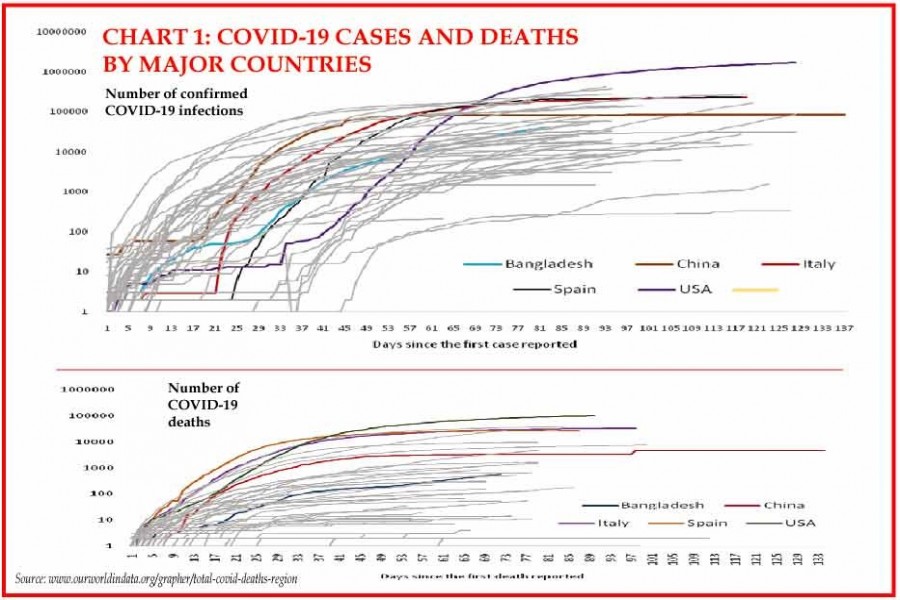Siyam Hoque
Published:2020-06-03 15:43:41 BdST
COVID-19 impact and the world economy in eight charts by RAPID
NEWS DESK
The first case of COVID-19 (Coronavirus) was reported in Wuhan, China, in late December 2019. As of 31 May, 2020, over 6.2 million COVID cases were reported in over 200 countries and territories around the world. Until that date, the virus killed over 3,71,000 people worldwide, with the highest number of deaths – over 1,05,000 – being reported in the United States.

The COVID-19 pandemic is causing an unprecedented disruption to the global economy. The resultant socio-economic impact is being transmitted through different channels. The International Monetary Fund (IMF) warned that the pandemic might push the global economy into the worst recession since the Great Depression of the 1930s, and far worse than the one triggered by the Global Financial Crisis in 2008-09, with the poorest countries being the hardest hit. As per IMF projections, the global economy would contract by 3.0 per cent in 2020, while the World Bank thinks the global economy will decline by 2.1-3.9 per cent. Using simulations from a general equilibrium modelling exercise, the Asian Development Bank (ADB) derives that the global economy could lose between $5.8 trillion and $8.8 trillion – equivalent to 6.4 per cent to 9.7 per cent of the global gross domestic product (GDP).

Global trade contracted by 3.0 per cent in the first quarter of 2020. According to the UNCTAD, the downturn would accelerate in the second quarter and so the world trade would decline by 27 per cent. This is echoed by the World Trade Organization (WTO), which has projected that the world merchandise trade would shrink between 13 and 32 per cent in 2020.

The COVID-19 pandemic is expected to cause huge job losses for migrant workers and thus affect remittance flows. According to the Institute for Public Policy Research, migrant workers are particularly likely to work in accommodation and food services, one of the most affected sectors in the COVID crisis. The World Bank projections found that global remittance flows would decline sharply by 20 per cent in 2020. Europe and Central Asia will experience the largest fall of 27.5 per cent, followed by Sub-Saharan Africa (23.1 per cent), South Asia (22.1 per cent), the Middle East and North Africa (19.6 per cent), Latin America and the Caribbean (19.3 per cent), and East Asia and the Pacific (13 per cent).
Worldwide FDI flow is expected to drop by about 35 per cent due to travel bans, disruption of international trade, and wealth effects of declines in the stock prices of multinational companies.

About 94 per cent of the world’s employed workforce are living in countries with some sort of workplace closure measures in place while around one-fifth of them live in countries that have closed all workplaces apart from those deemed essential. The decline in working hours around the world in the first quarter of 2020 is equivalent to approximately 135 million full-time jobs losses, which would increase to 305 million in the second quarter. The crisis is hitting young workforce, especially young women, more severely than any other group. The International Labour Organization (ILO) survey found that more than one in six young people have stopped working since the onset of the crisis. Young people who remain employed experienced a 23 per cent cut in their working hours.

The COVID-19 pandemic is likely to cause an increase in global poverty for the first time since the 1990s. According to a UNU-WIDER estimate, the number of people living in poverty could increase by 420–580 million. The World Bank estimates that the share of the population living in extreme poverty (incomesless than $1.90 per day) will rise by 40-60 million. The United Nations, however, put the number in the range of 84–132 million. According to the Save the Children and UNICEF, the COVID-19 pandemic could push an additional 86 million children into household poverty by the end of 2020.

The world could see the number of hungry people double in the aftermath of this crisis, as per the World Food Porgramme (WFP). As per the Global Report on Food Crises, there were 135 million people in acute food insecurity in low and middle-income countries last year. That figure could almost double to reach 265 million in 2020.

Prices of primary commodities plummeted in the first quarter of 2020. UNCTAD's free market commodity price index (FMCPI), which measures the price movements of primary commodities exported by developing economies, declined by a whopping 20 per cent in March. This is the highest fall in commodity prices in recent history with the comparable figure during the global financial crisis of 2008 when it was around 18 per cent. Quite strikingly, the prices of crude oil became negative in April, which however recovered in May.
Unauthorized use or reproduction of The Finance Today content for commercial purposes is strictly prohibited.


